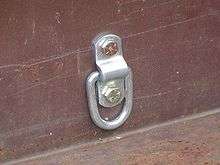D-ring

A D-ring is an item of hardware, usually a tie-down metal ring shaped like the letter D used primarily as a lashing point. The term is found interchangeably spelled in different forms, such as: Dring, d-ring or even Dee-ring.
A D-ring may be used at the end of a leather or fabric strap, or may be secured to a surface with a metal or fabric strap; though there are D-rings with a middle body designed to be welded to steel. Ideally, a D-ring swings freely after it has been secured. D-rings may vary in composition, geometry, weight, finish and load (rated) capacity.
Though there are differences, a weld-on pivoting link is commonly called a D-ring. Quite often the D-rings are mounted to the steel bumpers on the off-road vehicles. They feature round eyeholes and are welded right to the bumper, in order to allow a mounting point for a strap, tow chain or a pulling cable.[1] For off-road application, the D-rings are either welded directly the steel bumper, or may be bolted on, depending on the bumper construction.
To minimize obstruction when the D-ring is not in use, recessed tie-down rings are designed that accommodate the D-ring so it is flush to the surface. There are some non-recessed designs that have an adhesive base. The corresponding work load limits (WLL) must not be exceeded.
Lashing points and disambiguation of the term

Applications of D-rings include:
- For light loading applications such as clothing and luggage, D-rings made of plastics such as nylon may be used, as they weigh less and are impervious to rusting.
- Commonly, at the end of a tow-rope or chain, to allow one to create a bow around an item or part of an item that is being towed by a vehicle. They are commonly used with a chain to tether a boat to a dock or tree when it is being moored.
- In theatres, commonly used where a piece of scenery has to be lifted or "flown". D-rings are attached to the tops or bottoms of flats with a "drift line" and turnbuckle attached to adjust the "trim".
- A D-ring on an M16 or variant type rifle is used to increase the pressure on the extractor and reduce malfunctions. This D-ring is a rubber grommet shaped like a "D" and fits over the extractor spring adding tension to it.
- On breathing sets and scuba divers' buoyancy compensators
- A bit ring used on the bit of a horse.
- A type of carabiner.
- A part of a saddle (see saddle#D-ring)
- A type of ring binder.
- To attach a leash or tag to a dog collar or dog harness.[2]
References
- ↑ Zahl, Timothy (28 November 2017). "Understanding of Off-Road Bumpers". CARiD.com.
- ↑ "How to Make a Dog Collar On Your Own". Country Brook Design. Retrieved 2018-09-18.